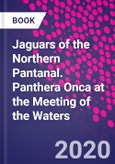Jaguars of the Northern Pantanal: Panthera Onca at the Meeting of the Waters details the lives and behaviors of this subpopulation of jaguars through one-of-a-kind photographs from 26 international photographers, as well as illustrations, maps, waypoints, scientific insights, field journal excerpts and personal narratives. The book seeks to understand how locals can coexist with these cats while benefitting financially through ecotourism. Users will find this book to be a conceptual model to apply to other subpopulations in order to save jaguars throughout North and South America.
It is an ideal resource for researchers and practitioners in wildlife conservation, naturalism ecotourism and biologists.
Table of Contents
Section 1: Introduction
Section 2: Individual jaguars
1. Identifying individual jaguars Paul Brooke and Paul Donahue
Section 3: Setting the scene
2. Habitat for Jaguars Paul Donahue
Section 4: Jaguar biology
3. Characteristics and physiology Paul Brooke
4. Once they were even larger Paul Brooke
5. Prey items of jaguars Paul Brooke
6. Bite force and consumption of prey Paul Brooke
7. Tree-climbing ability of jaguars
8. Territories, population density, and the jaguar corridor Paul Brooke
9. Flehmen response and scent lures Paul Brooke
10. The not so solitary Paul Donahue
11. Mating, cub rearing, and natal disperal Paul Brooke
12. Suffering and grooming Paul Brooke
13. Aging and geriatric jaguars Paul Brooke
Section 5: Jaguar tourism and conservation
14. Jaguar tourism Paul Donahue
15. The scourge of humans Paul Brooke
16. Jaguars have a cow problem Paul Donahue
17. Safeguarding cattle with cattle and water buffaloes Paul Brooke
18. Endocrine-disrupting chemicals Paul Donahue
19. Hydrophilia and mercury poisoning Paul Brooke
Section 6: Miscellaneous
20. Isca da On�a Paul Donahue
21. Miscellaneous observations and information Paul Donahue
22. Field notes Paul Donahue
23. Pantanal way points for 2017 and 2019 Paul Donahue
24. Jaguar identification guide examples and names Abbie Martin, Paul Brooke
Section 7: Final thoughts
25. Laying aside fear, embracing beauty Paul Brooke
Authors' biographies
Index








